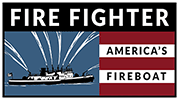Fire on the SS Normandie – February 9, 1942
It was May 1935 and a much different world when the SS Normandie, the Flagship of the Compagnie Générale Transatlantique and the pride of the French Merchant Marine Fleet, arrived in New York Harbor at the completion of her maiden voyage. Having captured the Blue Riband from the Italian Line’s SS Rex for her 4 day, 13 hour and 14 minute Westbound crossing of the Atlantic Ocean from Le Havre, the Normandie had begun a career which would see her complete some 139 trans-Atlantic crossings during the next four years.
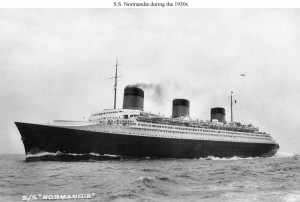
Despite her popularity, the outbreak of the Second World War in September of 1939 cut short the Normandie’s operations, as the threat posed by German U-Boats warranted her owners to order her to remain in New York Harbor at the completion of her 139th Atlantic crossing. Moored at Manhattan’s Pier 88 for the next year and a half, the Fall of France on May 15, 1941 led to Normandie being impounded at her pier and following the American entrance into the war the ship was seized by the US Government under the right of Angary. Transferred to the ownership of the US Navy on December 27, 1941 and renamed the USS Lafayette, the Normandie became the subject of several design reviews before the decision was reached that the ship would be best utilized as a fast Troopship.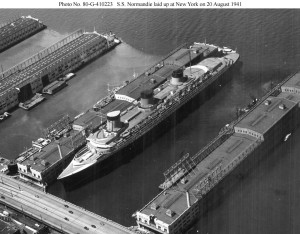
On December 28, the luxurious French ocean liner SS Normandie ceased to exist. A swarm of workers from Robins Dry Dock and Repair Co. came aboard and removed the famed Art Deco fixtures from throughout the vessel. Conversion work on the enormous ship originally scheduled to take less than a month, but the projected completion date was delayed by the enormity of the task from late January 1942 to the end of February. Safety protocols were often ignored as crews worked at a feverish pace to complete the conversion.
By early February, the majority of topside, exterior, and forward interior renovation work had been completed aboard the ship, which now wore a wartime camouflage paint scheme. Conversion efforts still continued apace in the vessel’s stern however, where on the afternoon of February 9, 1942 workers in a former 1st Class Lounge were simultaneously stripping wood fittings and welding fixtures when a chance spark found its way into a pile of highly flammable Kapok life jackets and ignited. Starting at 2:37PM, the fire quickly went out of control and thanks to large piles of heavily lacquered decorative wood providing ample fuel. Due to Lafayette’s internal firefighting system being disconnected and her water pumps deactivated as part of the conversion process, workers in the immediate area of the fire were forced to use a bucket brigade and wet blankets to quell flames, without success. By the time the initial call came into to the New York City Fire Department at 2:45PM, the fire was already moving quickly into adjacent compartments and showed no signs of stopping.

The initial FDNY response brought several nearby ground units including fireboat John J. Harvey from her post at the foot of Bloomfield Street. The situation aboard the Lafayette should have been under control in short order. However, fate and the metric system conspired against the ship because all her standpipe connections were threaded and sized in the European measurement and thus rendered unusable by any U.S. fire apparatus. With no ability to fight the spreading flames from land other than using truck and engine-mounted monitors on the exterior, a second alarm was rung out at 3:01PM for additional ground units and to bring a second fireboat to the scene – a call answered by the crew of the recently wartime-gray-painted Fire Fighter at Pier 1A. Making her way up the ice-flecked Hudson River to reports that ship was being abandoned after the fire had found its way into the Lafayette’s grand stairway and had reached a stockpile of over 2,000 canvas bunks, the Fire Fighter came on scene shortly after the fourth alarm had been sounded and immediately moved to the Lafayette’s midship to setup a firebreak on the now totally out-of-control blaze.
Four other FDNY fireboats and a small fleet of commercial tugboats joined the effort to contain the fire aboard the stern of the Lafayette. Hampered by a stiff westerly wind coming off the Hudson River that fed and drove the intense fire towards Lafayette’s bow, where a group of shipyard workers huddled awaiting rescue. New York City Fire Commissioner Patrick Walsh arrived shortly after 3:15PM and promptly ordered all ground and waterborne firefighting apparatus to begin surround-and-drown efforts on the fire. Moving alongside the John J. Harvey to pin her bow against the midship of the Lafayette after, Fire Fighter raised her aft tower monitor and sent huge volumes of water upwards onto the decks of the Lafayette.
Despite the efforts of FDNY fire crews aboard the Lafayette and the fleet of fireboats and civilian tugs alongside, by the time the Winter sun began to set over New Jersey the fire had spread through the entire superstructure of the former ocean liner. While the intense flames had left much of the upper works totally ravaged, they had also consumed much of the fuel that sustained them which allowed FDNY units to gain the upper hand on the situation around 5:45PM. Perhaps spurred by the opportunity to save the ship’s engineering spaces from further damage, the decision was made by the Port Admiral to continue high-volume fire suppression efforts despite the fact that the Lafayette was beginning to list to Port from the weight of water pumped aboard, much of which had since frozen to the ship
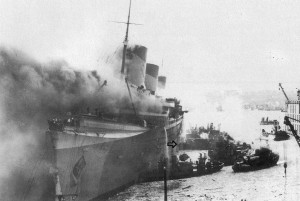
Fire Fighter (indicated by the arrow) on scene fighting the SS Lafayette. Note: group of workers trapped on the bow preparing to descend to pier by ladder.
Working amidships and pumping at high capacity onto the remaining hotspots through the evening, Fire Fighter’s crew kept a watch on the hull of the Lafayette as she began to strain at her dock lines. Despite efforts to counter-flood her starboard side to bring her back to an even keel, Lafayette continued to heel over and was ordered abandoned again at 8:00PM when her list neared 20 degrees. Regardless of the obvious danger posed by her position, Fire Fighter and her crew were ordered to remain in place and continue pumping efforts to prevent the fire’s spread to the pier building or other structures in the area. Fire Fighter’s crew continued this duty for the next six hours, and succeeded in almost totally extinguishing all remaining fires aboard the Lafayette by 2:00AM the following morning, permitting a skeleton U.S. Navy crew were able to re-board the ship to begin mop-up operations.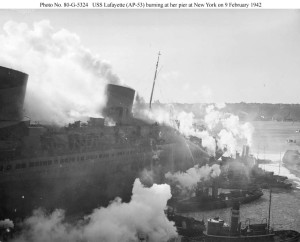
After nearly twelve hours, Fire Fighter’s weary crew came inside from the frigid night for a quick chance to warm up and dry off. Fire Fighter remained firmly pressed into the midship hull of the Lafayette until about forty minutes later when the unmistakable sound of heavy lines parting brought her entire crew back outside. The port rail of the Lafayette was capsizing on top of them, Fire Fighter’s crew had to race into action to try to move their ship out of danger. With Lafayette’s threatening to crush Fire Fighter underneath the leviathan as she rolled over, Fire Fighter and the John J. Harvey were able to get clear and made a narrow escape shortly before the Lafayette fully rolled over onto her port side alongside Pier 88 at 2:45AM on February 10, 1942, extinguishing the remaining fires onboard.
Having narrowly avoided an untimely end to her short career, Fire Fighter and her crew remained on scene with the Lafayette until all remaining hotspots were extinguished, a process that lasted all day on February 10th. Finally released to her berth at Pier 1A, Fire Fighter left the once-opulent SS Normandie as she lay firmly dug into the mud of the Hudson River. Lafayette remained there until August 1943 when she was raised and righted in the world’s most expensive salvage operation at the time. She was again considered for further use as a warship or transport, but the hulk of the Lafayette spent the rest of the war tied up at the Brooklyn Navy Yard before finally being sold for scrap in October 1946
Fire Fighter and her crews would have more perilous assignments in wartime New York Harbor. As she was made fast to her pier and washed down by her crew following her marathon duty at Pier 88, Fire Fighter’s bow faced the site of her next major call to action: The Caven Point Army Depot.

